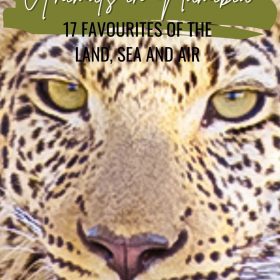Namibia is home to some of the most fascinating animals on the planet. Among its incredible variety of species, you’ll find a few surprises and some impressive adaptations to the desert climate. Life isn’t easy for wildlife in this harsh land, but from the lions of Etosha to the meerkats in the desert, wildlife is thriving.
There are over 200 species of land mammals and more than 40 varieties of marine mammals native to Namibia. That’s not even counting the hundreds of birds, reptiles, amphibians, and insects. There’s so much to see and experience.
*This site uses affiliate links and I may earn a small commission when you use my links and make a purchase without incurring an additional fee yourself.
Thank you for supporting this website. See my disclaimer page for more details.
Whether you’re an avid bird watcher or a big cat enthusiast, Namibia’s wildlife will leave you spellbound. Here are some of the favourite animals in Namibia, and a few things you should know about each one.
Animals in Namibia
Plains Zebra:
Pressure on species – near threatened
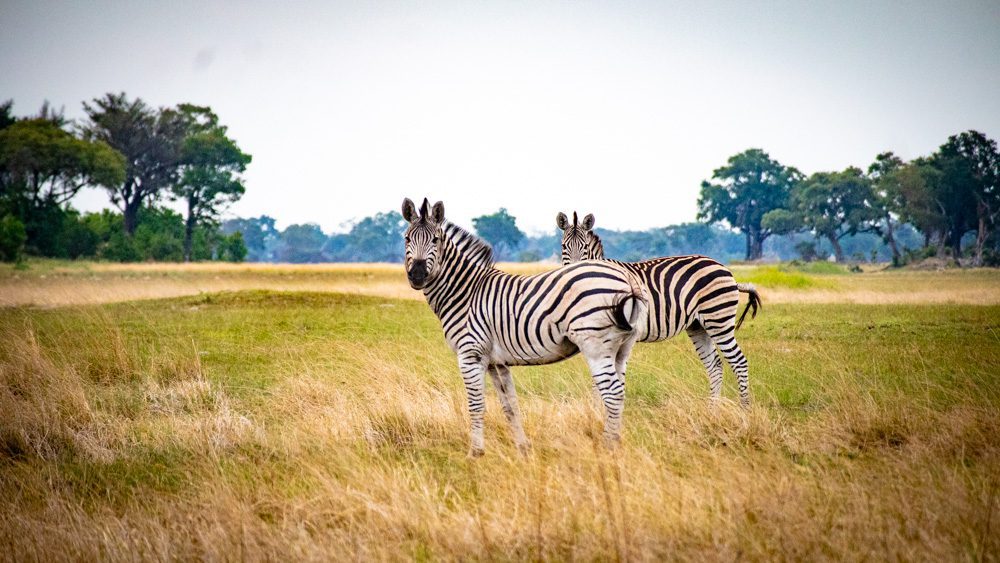
The Plains Zebra, also known as the common zebra, is the most widespread and plentiful species of zebra. They’re found in Namibia and other countries in southern and eastern Africa.
Found primarily in grasslands and savanna woodlands, they live in areas like Etosha National Park and the Caprivi Strip. As herbivores, their diet mainly consists of grass, leaves, and bark.
They have the unexpected ability to communicate through various vocal sounds and even facial expressions. These traits make them a lot more interesting than you might have thought!
Standing about 4 feet at the shoulder and weighing up to 770 pounds, each zebra has a unique stripe pattern, similar to human fingerprints. Their stripes play an important role in evading predators – confusing lions, hyenas, and cheetahs in their hunt.
These zebras live in groups known as harems, consisting of a stallion, several mares, and their young. Several harems often gather to form larger herds of as many as 20 zebras.
Unfortunately, they’re classified as “Near Threatened” by the International Union for Conservation of Nature, or IUCN. This is primarily due to habitat loss and hunting.
Great Hammerhead Shark:
Pressure on species – globally critically endangered, but not in Namibia
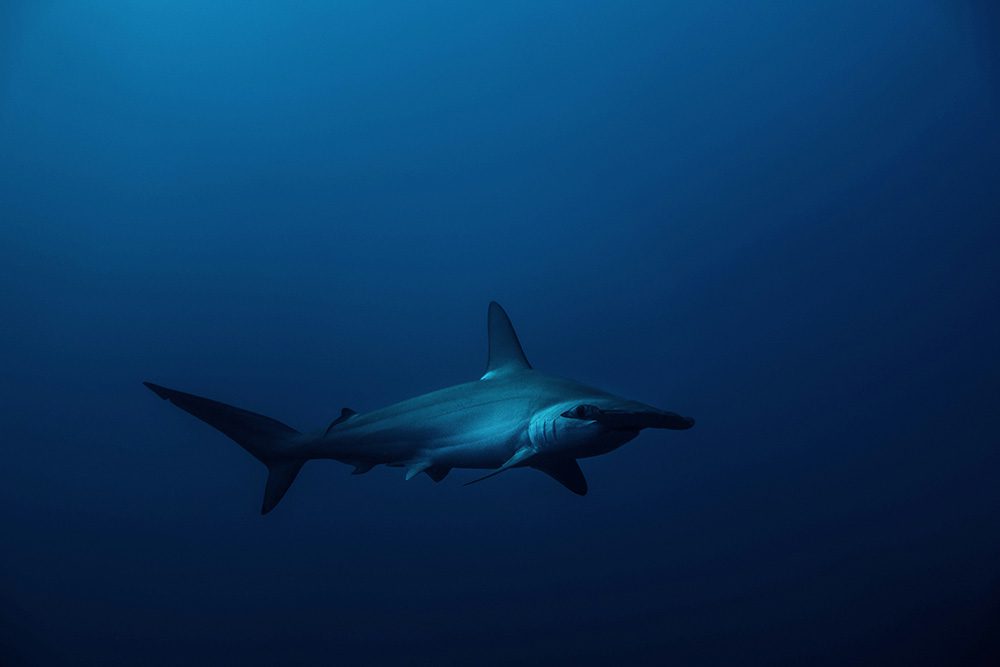
With 997 miles of coastline, it’s impossible not to include marine wildlife with the animals in Namibia. The great hammerhead shark is the largest of its kind, and can reach lengths of up to 20 feet. They’re found in the tropical and warm temperate waters worldwide, including the Atlantic Ocean off Namibia’s coast.
We know them by their unique hammer-shaped head, which provides a wide visual field. This solitary apex predator has quite a varied diet, eating crustaceans, fish, smaller sharks, and cephalopods like octopus. Its favourite prey is stingrays, and they’ll use one end of their hammer to hold the stingray down while eating it.
Great hammerheads give birth to live young instead of laying eggs. One shark will have litters of up to 50 pups every two years after a gestation period is about 11 months. Once they’re born, the mom’s responsibility ends, and the pups are on their own.
Despite its size and strength, great hammerheads are rarely a threat to humans and often show curiosity towards divers. They should be treated with caution and respect in the water, but they don’t pose any real threat.
While not endangered in Namibia, the species faces global decline due to overfishing. They’re listed as critically endangered by the IUCN.
Ground Pangolin:
Pressure on species – vulnerable

The ground pangolin, native to Namibia and other parts of Africa, can be found in savannas, forests, and grasslands. These funny little mammals are unique for their keratin-based scales, similar to human hair and nails.
Pangolins are often called scaly anteaters due to their diet of ants and termites, reached with their long, sticky tongues. These solitary nocturnal animals are known for rolling into a ball when threatened. They mate once a year, and give birth to a single ‘pangopup’. The newborn sports soft scales that harden a few days after birth. Pangopups will hang out with mom until they’re about 2 years old.
Despite having poor eyesight, pangolins have excellent senses of hearing and smell. They face considerable threats from habitat loss and poaching. Sadly, they’re the most trafficked mammal worldwide for their scales and meat.
However, Namibia’s ground pangolins are only classified as vulnerable by the IUCN. These guys are also in danger from hazards like low-strung electric fences.
South African Ostrich:
Pressure on species – not endangered
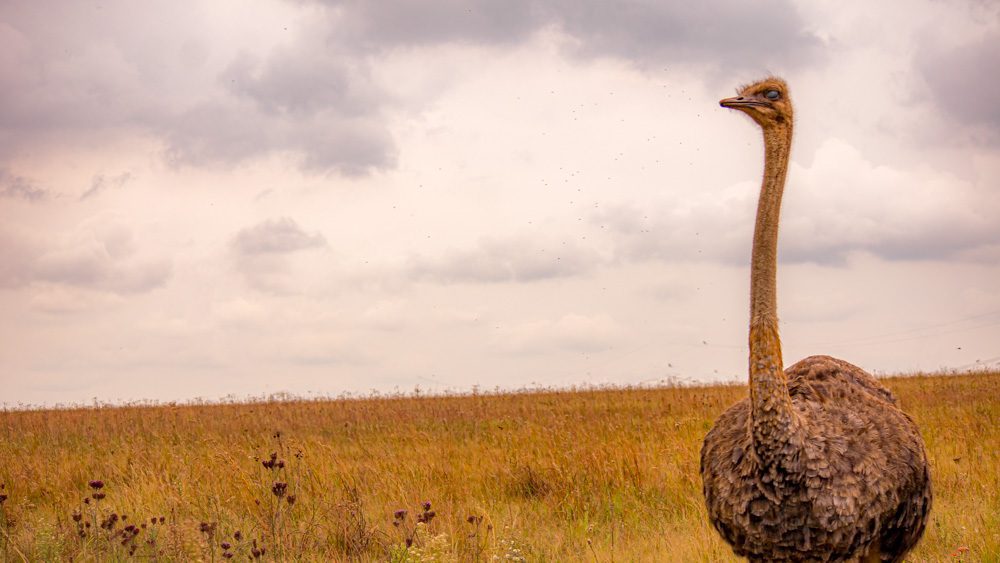
The South African ostrich is also known as the black-necked ostrich, Cape ostrich, or southern ostrich. It’s a subspecies of the common ostrich endemic to Southern Africa.
Namibia’s ostriches are well adapted to its arid conditions and can go for more than 2 weeks without water. Their bodies absorb water from the plants they eat.
As the largest bird in the world, the ostrich can stand up to 9 feet tall and weigh as much as 320 pounds. They have the largest eyes of any land animal, each eye measuring up to 2 inches in diameter.
Despite being flightless, ostriches are well-known for their speed. They can run up to 45 miles per hour, making them the fastest two-legged animal on earth.
The birds often live in groups of up to 50 individuals. They lay their eggs in big communal nests – typically shallow pits in the ground. Then it’s the male ostrich’s responsibility to incubate these eggs for about 42 days.
Once the chicks hatch, they’ll stay with mom for anywhere from 9 to 18 months, while she teaches them how to ostrich.
Cape Fur Seal:
Pressure on species – classified as ‘least concern’

The Cape fur seal, often referred to as the brown fur seal in Namibia, is an interesting and important marine mammal. As the largest species in the fur seal family, these animals are an essential part of the marine ecosystem along the southern African coast.
The population in Namibia has the distinction of being one of the largest colonies in the world. It’s estimated that several hundred thousand seals can be found along the Namibian coast. They particularly thrive in areas like the Cape Cross Seal Reserve.
These seals are distinguished by their muscular bodies, impressive agility in water, and their unique fur. Historically this thick, warm fur has made them targets for hunting.
Despite their large population, the Cape fur seal faces several threats that put them at risk. Habitat loss is a real concern, as coastal development and human activities encroach upon their natural breeding grounds.
Their numbers aren’t helped by the fact that fur seals only give birth once a year, and have only one pup at a time. Gestation is 8 months but begins after a 4-month delay before implantation. The seal will mate again 6-10 days after giving birth, and the process begins again.
The Namibian government has also implemented an aggressive culling program. It’s something that has been a subject of international debate and concern. However, the IUCN classifies the Cape fur seal as a species of “Least Concern,” indicating that they are currently not at immediate risk of extinction.
African Savannah Elephants:
Pressure on species – not endangered in Namibia
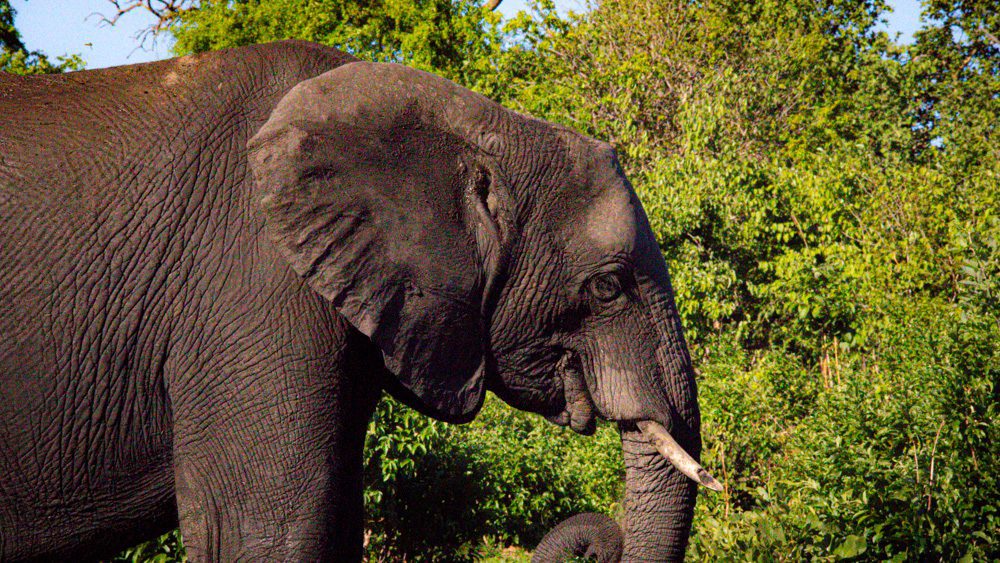
African Savannah elephants, also called Bush elephants, are the largest of the 3 elephant species. They’re also the biggest land animals on Earth.
A great many of Namibia’s elephants live in Etosha National Park. The park is currently home to more than 2,500 elephants. There are also an estimated 350 desert-adapted elephants living throughout this arid country.
Though there is no genetic difference between the savannah and desert elephants, the bodies of the desert dwellers do look more compact, owing to their more spare diet. Their feet also cover a bit more ground, keeping them from sinking into the sand
Savannah elephants have quite complex and close-knit family units. A typical family consists of around ten females and their calves. Several of these families together will form a clan, which can include several hundred elephants. As elephant society is strictly matriarchal, the clan is led by an older female.
The males, or bulls, typically mingle with the herds for mating purposes only. A female will become pregnant only every 4 or 5 years, and give birth 22 months later. Normally, only one calf will be born at a time, although twins do happen occasionally.
African Leopard:
Pressure on species – vulnerable globally
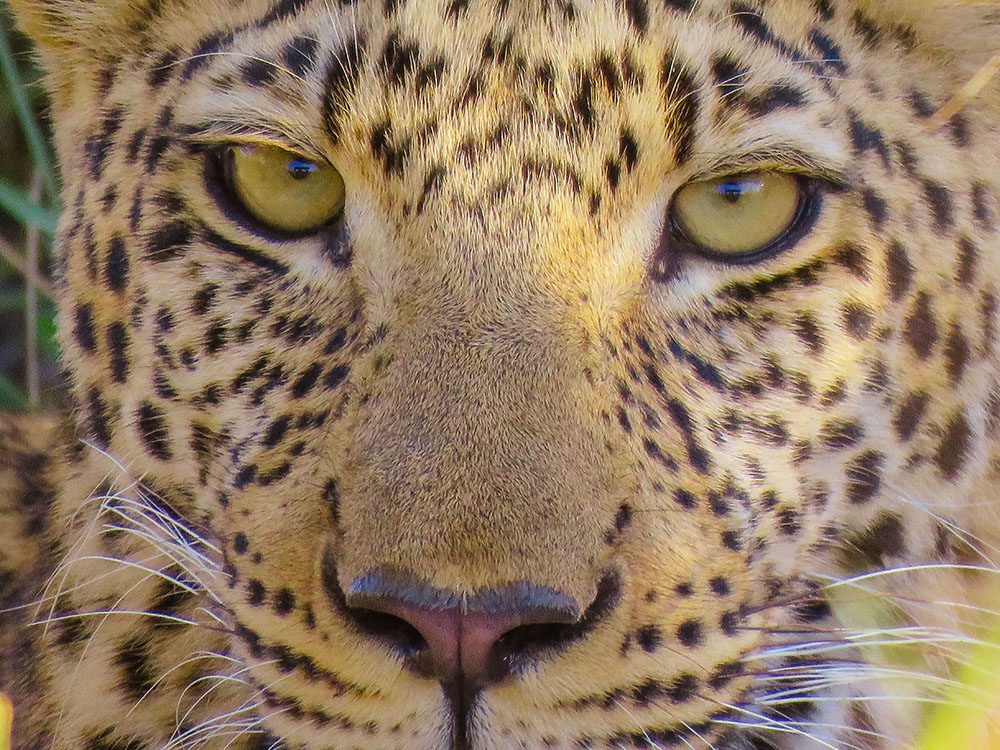
African leopards are among the most iconic and mysterious creatures of the African wilderness, particularly of Namibia. These nocturnal cats demonstrate some fascinating behaviours and skills. For example, they have a remarkable adaptability to different habitats, and their incredible climbing abilities are astounding.
They’re the epitome of self-sufficiency, preferring solitude and teaching their young to be independent from an early age. A female leopard usually gives birth just once every 15-24 months. A litter of 2-4 cubs is born after a gestation period of about three months. The mother leopard will raise them single-handedly, teaching them to hunt and survive on their own.
A leopard’s diet is incredibly varied and includes prey like antelopes, rodents, and birds. They’re known for their remarkable habit of hoisting prey into trees to eat away from scavengers, displaying incredible strength. Leopards are considered to be the most powerful of the big cats
African leopards are found in most parts of Namibia, apart from the true desert. They are extremely adept at camouflaging themselves. A leopard sighting is always cause for excitement.
Kirk’s Dik-Dik:
Pressure on species – classified as ‘least concern’
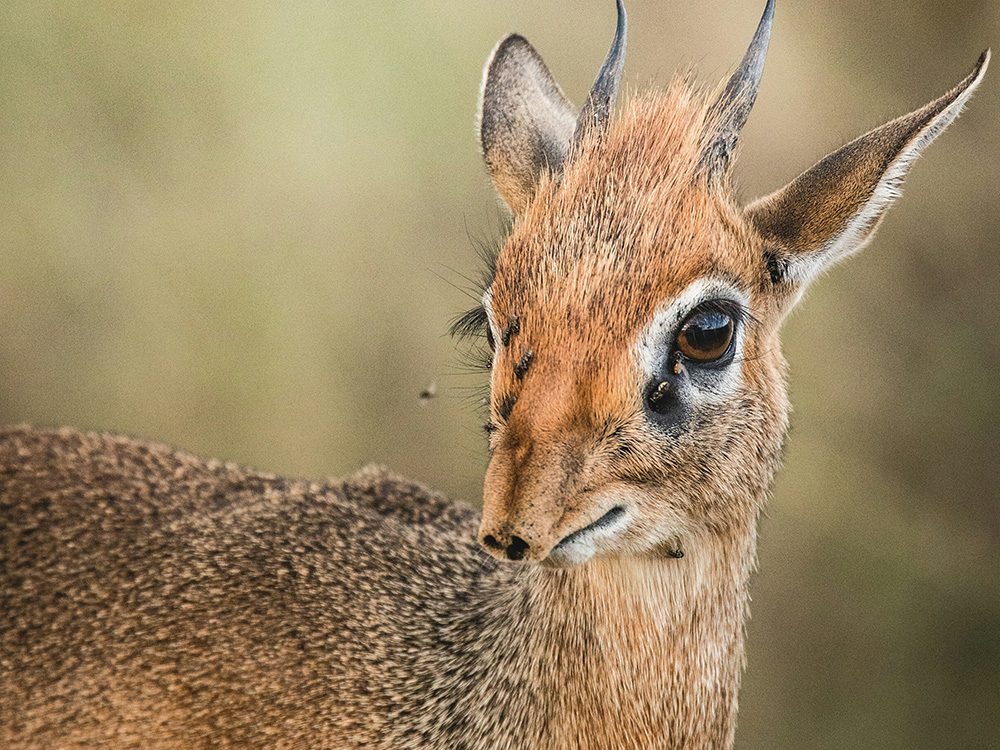
Kirk’s dik-dik is a sweetly tiny antelope that holds a unique place in the variety of wildlife in Namibia. These petite creatures typically reach only about 12-16 inches in height at the shoulder. They’re perfectly adapted to life in savannahs and grasslands.
Their size and spryness make them adept at navigating through the underbrush and avoiding predators. One of the most distinctive features of Kirk’s dik-dik is their elongated snout, which is not just for aesthetics. It helps in thermoregulation, cooling the blood during Namibia’s hot days.
Unlike many animals on our list, Kirk’s dik-dik are quite the romantics. They’re monogamous, a rarity in the antelope world, often forming lifelong pairs. Twice a year, the female will give birth to a single calf after a gestation period of about six months.
These calves are well-hidden in grassy areas for the first few weeks of their life, to protect them from predators. Dik-diks are able to reach sexual maturity in just seven months, ensuring a quick generation turnover.
Their territory, marked by the male through scent glands below the eyes, is fiercely defended against intruders.
Southwestern Black Rhino:
Pressure on species – critically endangered
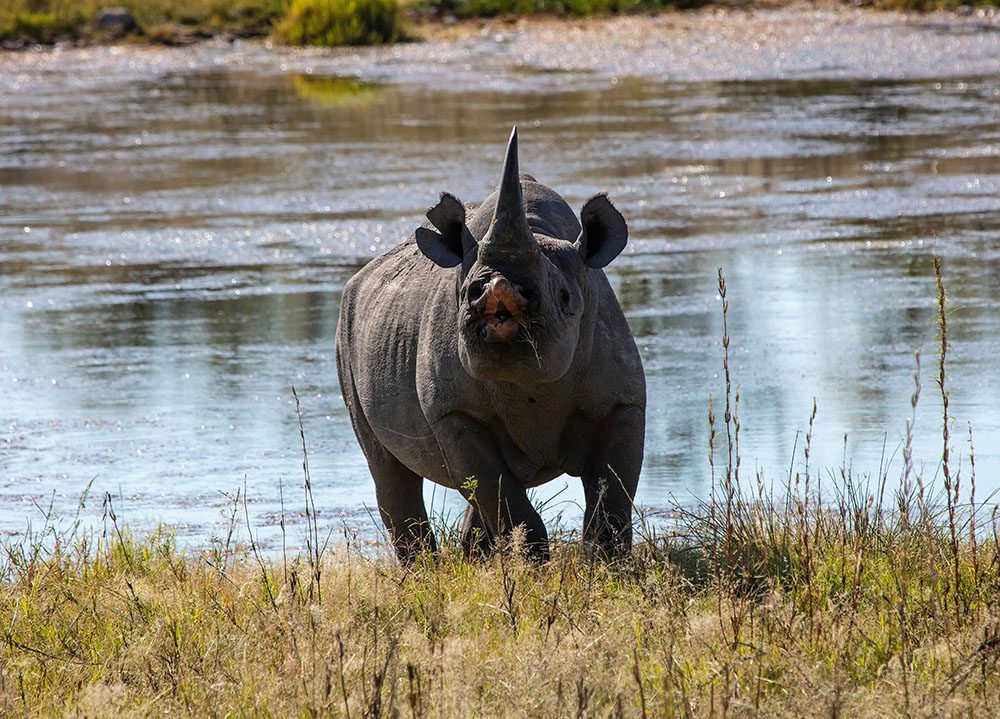
Black rhinos, with their prehistoric appearance and impressive stature, are one of the most symbolic species native to Namibia. Despite their name, black rhinos are actually more grey-brown in colour. They’re distinguishable from their cousins, the white rhinos, by their pointed, hooked lips. It’s used to aid in browsing shrubs and trees.
They’re typically solitary creatures, known for their somewhat cantankerous demeanour. They do have a reputation for being more aggressive than white rhinos. Black rhinos have excellent hearing and a keen sense of smell, which compensates for their fairly poor eyesight.
Black rhinos have a slower breeding rate, which is one of the challenges in boosting their population. Females typically give birth to just one calf every two to three years, after a gestation period of 15 to 16 months. The calves are incredibly vulnerable in their early years, often staying with their mothers for protection until they’re about three years old.
Namibia has become a stronghold for these animals. Significant populations are found in areas like Etosha National Park, Damaraland, and Palmwag. But despite Namibia being home to about a third of the black rhino population in Africa, the species is still classified as “Critically Endangered” by the IUCN.
Southeast African Cheetah:
Pressure on species – vulnerable

Cheetahs, the world’s fastest land animals, are a distinctive member of Namibia’s wildlife. They are famously capable of sprints up to 70 miles per hour. Their hunting ability is given a boost by their slender build and powerful legs. They typically live in open areas like the grasslands and savannahs of Namibia.
Male cheetahs live in groups called coalitions, usually with their brothers. Females tend to remain solitary, especially when they’re raising cubs. They’ll tend the cubs, teaching them life skills, for about 18 months. At this point, the mother will go off on her own, as will any female cubs, and the males will stay together.
Having cubs is a challenge for cheetahs. Litters of three to five cubs are born only about every 17-20 months, and cub mortality rates are high. Despite these hurdles, Namibia’s conservation efforts, including habitat preservation and anti-poaching initiatives, are making strides.
One of these efforts is Namibia’s Cheetah Conservation Fund. This international organization, located in Otjiwarongo, is focused solely on the preservation of cheetahs. They welcome visitors in support of their mission; if you’re in the neighbourhood, it’s an amazing place to visit.
Cheetahs are classified as vulnerable by the IUCN due to habitat loss and poaching.
African Fish Eagle:
Pressure on species – classified as ‘of least concern’
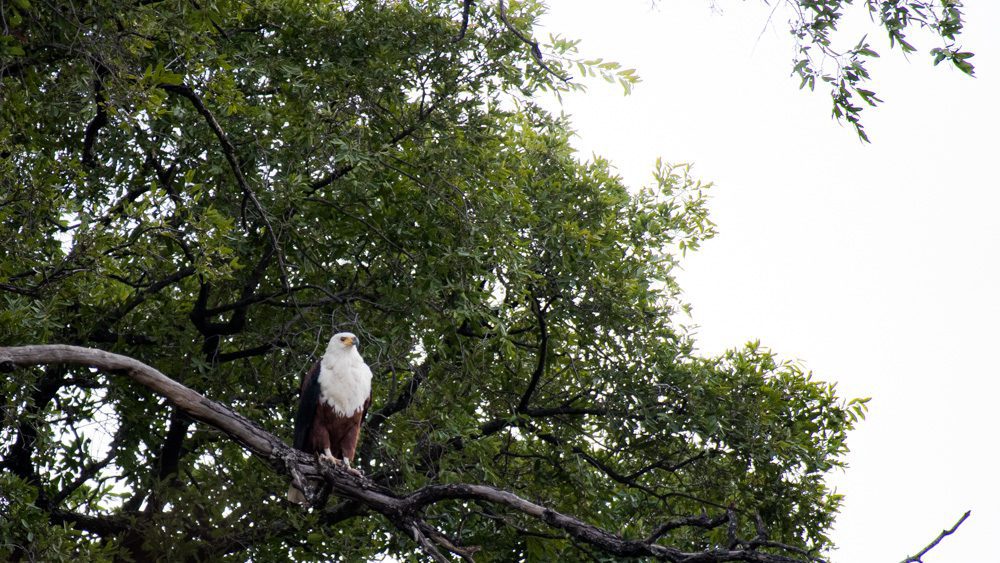
The African fish eagle, Namibia’s national bird, is a striking-looking raptor. With its white head and chest, contrasting rich brown body and wings, and haunting call, it is one of the most recognizable birds in sub-Saharan Africa.
With wingspans between 6 and 8 feet, they’re surprisingly small, weighing only 4-8 pounds. As is often the case in birds of prey, the females are larger than the males.
These eagles are most often found near large bodies of water – rivers, lakes, and coastal regions. They have remarkable fishing skills, and it’s thrilling to watch them swooping down to snatch fish from the water with their sharp talons. Their diet can also include small mammals and even other birds.
African fish eagles are known to mate for life, building large nests in tall trees or cliffs near water. These birds typically lay 1-3 eggs each breeding (dry) season, and both parents share incubation and chick-rearing duties.
The population of African fish eagles is estimated at around 300,000, indicating a healthy number across their vast range.
Southern Giraffes:
Pressure on species – classified as ‘least concern’

Southern giraffes, distinguished as the tallest mammals on Earth, really are an enchanting sight on Namibia’s landscape. Towering up to 18 feet, with unique spotted coats whose individual patterns are as distinct as a human fingerprint, they’re a marvel of nature.
These elegant giants are found mainly in savannahs, grasslands, and open woodlands. Here they graze on leaves, flowers, and fruits, mainly from acacia trees. Their height gives them a significant advantage, allowing them to reach foliage other herbivores can’t.
Giraffes are also known for their unusual drinking behaviour. They must splay their legs or bend their knees to reach the water, making them vulnerable to predators. You’ll often see other giraffes in their tower standing guard while they take turns drinking.
Giraffes have quite a slow breeding rate. Females typically give birth to a single calf after a gestation period of about 15 months. The newborn calves are exceptionally resilient and able to stand and even run within a few hours of birth. This is after their initial fall, as giraffes give birth standing up.
Common Hippopotamus:
Pressure on species – vulnerable
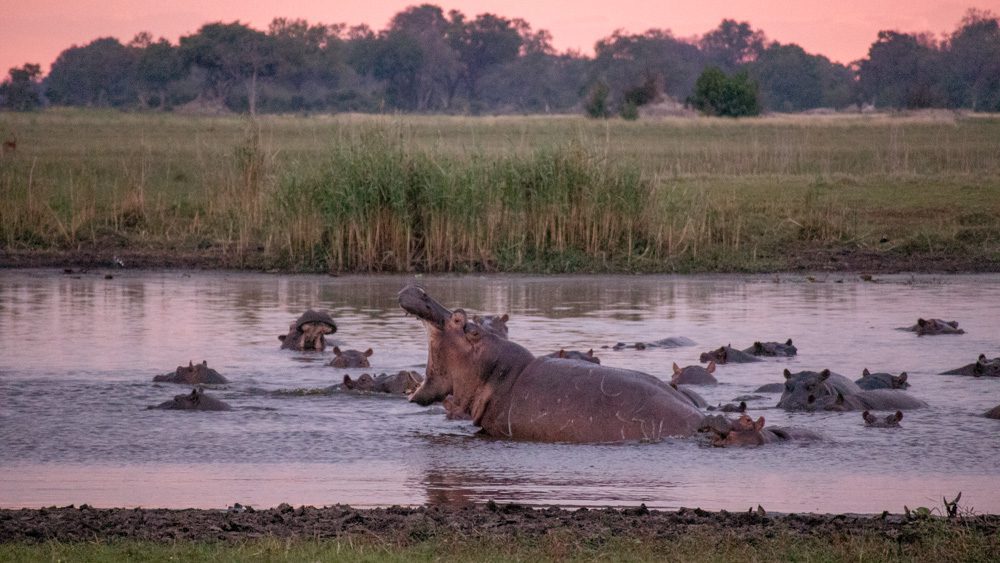
The common hippo is the third-largest land mammal on earth. The semi-aquatic giants are most commonly found in and around rivers, lakes, and swamps. They spend much of their time submerged to keep their massive bodies cool under the African sun.
Hippos are known for their amphibious lifestyle, with adaptations like their eyes, ears, and nostrils located high on their heads. This allows them to remain mostly submerged while still being able to see, hear, and breathe.
Despite their bulky frame and short legs, hippos are surprisingly agile in the water. But they can’t actually swim – instead, they walk along the bottom of the river. They also can be pretty fast on land.
Hippos are primarily herbivores, grazing on grasses at night. They’re also known for their social behaviour, living in groups called pods, which are generally led by a dominant male. They are very territorial and kill an estimated 500 people per year.
Female hippos typically give birth to a single calf every two to three years, following an eight-month gestation period. Calves are born underwater and need to swim to the surface to take their first breath. Early life is perilous for the young hippos, who are vulnerable to predators. They can even be at risk from adult males within their own pod.
Greater Kudu:
Pressure on species – not endangered

Greater Kudus are a gorgeous species of antelope. They’re distinguishing feature is their impressive long, spiral horns, which are present only in males.
These horns can grow up to 6 feet long, the longest of any antelope, and are used to defend against predators. An interesting fact about kudus is their incredible jumping ability. Despite their size, they can easily clear heights of over 8 feet. This makes them one of the most athletic antelopes in Africa.
Kudus are well-adapted for survival in Namibia’s arid environment. They can go for long periods without water, absorbing moisture from the leaves that they eat. They live well on bush and scrub woodland.
Kudus are mainly found in woodlands and bushlands of Namibia. They particularly seek out areas where there is lots of cover for hiding and browsing. Female kudus will give birth to a single calf after a gestation period of around seven to eight months. The mother hides her calf for the first few weeks of its life to protect it from predators.
Females for groups with their young of anywhere from 6 to 20 animals. Males will sometimes form small bachelor groups, but most often enjoy solitary lives.
Lion:
Pressure on species – vulnerable
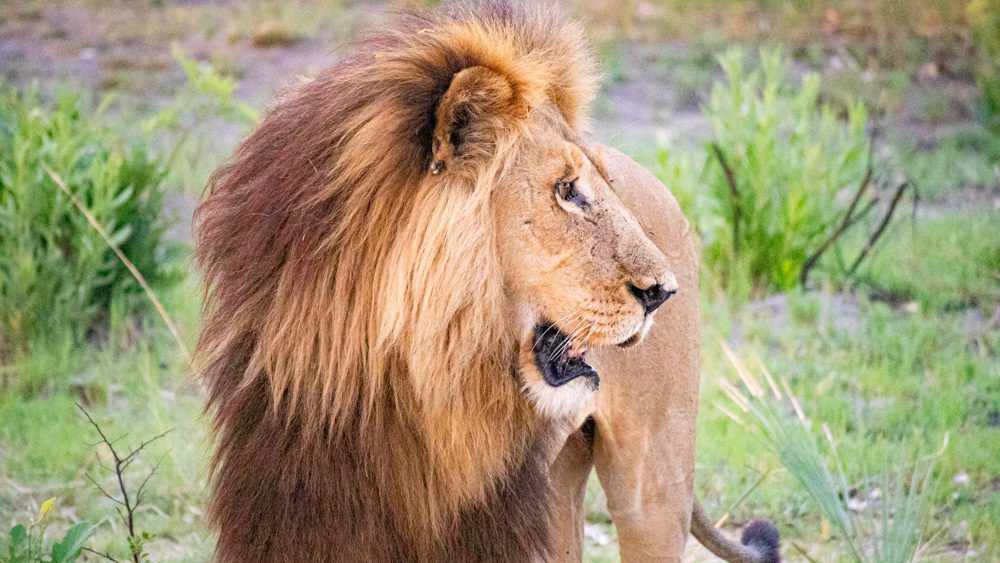
Lions are a favourite animal throughout southern Africa, and Namibia is no exception. They’re found most often in the northern regions. Etosha National Park is home to the largest lion community, with an estimated population of 335 animals.
These lions can also be found in Khaudum Park, in northwest Namibia, Kaokoland, and Caprivi, as well as in the northeastern Kunene Region. While counts vary, Namibia is currently estimated to be home to about 800 wild lions.
Namibia’s lions are uniquely adapted to survive the tough desert conditions. The lions found here form a distinct subspecies, the desert lions. They tend to be smaller, roaming larger territories. And unlike their savannah counterparts, males will not kill a pride’s young to bring the female back into oestrus.
In general, a lion will have new cubs about every two years. After a gestation period of roughly 110 days, a litter of two to three cubs is born. The females will stay with mom’s pride for life. The males, though, will venture out on their own when they’re around 2 years old.
Meerkat:
Pressure on species – classified as ‘least concern’
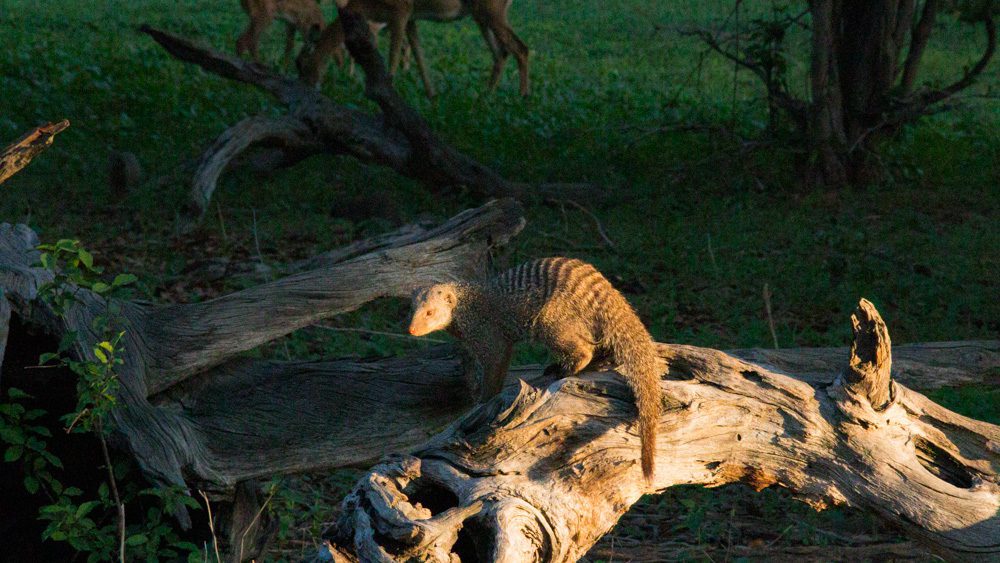
These beloved little creatures are sociable members of the mongoose family. They’re a common sight in the Kalahari Desert, which accounts for about one-third of eastern Namibia. They also live in a large part of the Namib Desert and other arid spots.
In Namibia, you can find two distinct subspecies of meerkats. One has a lean body and thin tail and can be spotted in eastern Namibia, around the Kalahari Desert. The other is recognized by its paler colouring and more buff physique. It’s native to western Namibia, specifically Damaraland and the Namib Desert.
These little guys live in large family units or ‘clans’, of up to 30 members. Omnivorous by nature, their diet is incredibly varied, ranging from venomous scorpions to small birds and termites.
Their excellent hunting skills of small vertebrates, insects, and grubs keep them well-fed. Meerkats are known to be a cooperatively breeding species, where the entire group takes part in raising their young ones. They can have several litters in one year – after a gestation period of roughly 11 weeks, a meerkat usually gives birth to a litter of 2-5 pups.
South African Oryx:
Pressure on species – not endangered

The South African oryx (from the Greek word for pickaxe), or gemsbok, is a unique antelope species. For many people, it symbolizes resilience in the harsh desert landscapes of Namibia. They’re easily recognized by their very striking black-and-white facial markings, long, straight horns, and large tan bodies.
These beauties are known for their exceptional speed and stamina, and for their use of those gorgeous horns in defence against predators. They’re also admired for their ability to survive in Namibia’s extreme conditions.
The Namib Desert is one of the world’s oldest and driest deserts, and the oryxes that inhabit it possess some pretty impressive survival traits. They have a unique thermoregulatory system that allows them to raise their body temperature to reduce sweating and conserve water.
They also have light-coloured coats that reflect sunlight, and cool down by channelling blood to their nasal passages. Plus, these oryxes efficiently absorb moisture from their diet of grasses, leaves, and fruits. They conserve a lot of this water through their bodily functions, producing highly concentrated urine and dry faeces.
These adaptations let them thrive in one of the planet’s most challenging habitats.
Oryxes will breed throughout the year, producing a single, well-developed calf after an 8.5-month gestation. The calves stay with the herd after weaning at about 4 months. But they no longer hang out with mum.
To Sum it Up: Animals in Namibia
Namibia really is a treasure trove when it comes to land and sea animals. From the black rhino roaming the plains, to the fur seals barking on the Atlantic shore, these animals are not just a part of Namibia’s environment but also an integral part of its existence.
When you find yourself in the company of these creatures, take a moment to appreciate the wonder of their existence and the importance of their conservation. A large part of the thrill of Namibia lies in its spectacular wildlife. Enjoy!
Pin to Pinterest to come back to this article for later
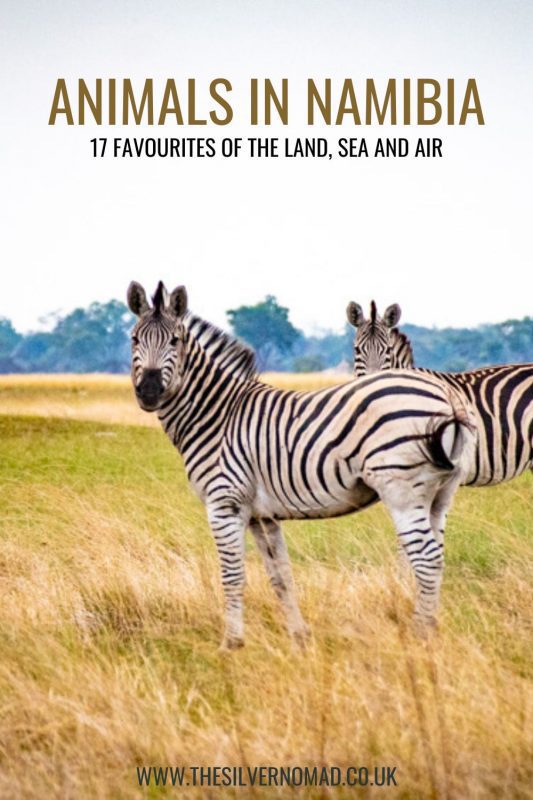
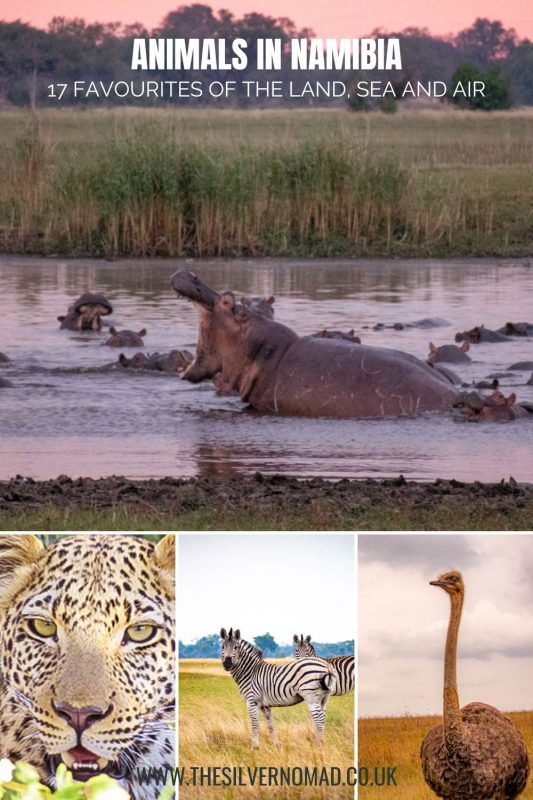

Use these Namibia Travel Tips to plan your adventure!
- Plan your trip with these Namibia Travel Guides.
- Get the best deals on flights with Skyscanner.
- Find the perfect place to stay in Namibia on Booking.com.
- Buy your e-sim before you go with Airalo.
- Explore more about Namibia with local experiences.
- Don’t forget to arrange your travel insurance.

